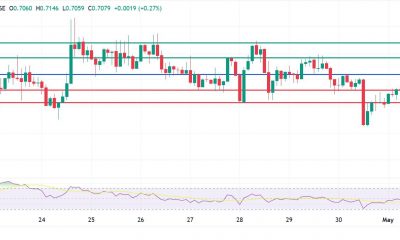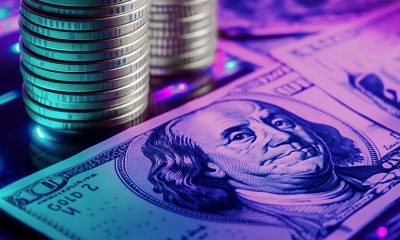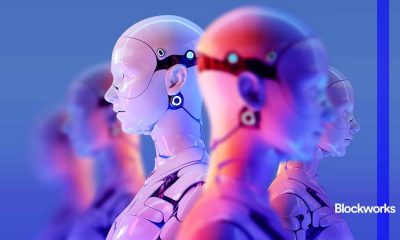

Cryptocurrency
Decentralization and democracy: Three centuries of debate – Crypto News
On this day, September 17th, 1787, delegates from all over the former British colonies in North America gathered at Independence Hall in Philadelphia, Pennsylvania, to overthrow and replace the United States government.
The one they replaced—the Articles of Confederation—had failed so thoroughly as to be a non-entity by the time the delegates gathered at Philadelphia. The one they replaced it with— the United States Constitution—was the result of an intense summer of complex debate surrounding one question: how can we build a functional, authoritative government that does not eventually trend toward autocracy?
The brief but powerful legal document that resulted is still the most successful decentralized system that has ever been designed; one that, on aggregate but not without error, has trended toward greater liberties and enfranchisement for its constituents over time, not less.
It is a profound and tragic irony, then, to see the United States so unapologetically positioned at the top of the world in the 21st Century, a vast superpower whose interests and institutions hold sway over all of global society. For many, the first nation ever to free itself successfully from internal tyranny has itself become the very kind of tyrant it swore off in 1776.
Now, not quite 250 years later, a global urge for decentralization is pushing back against the United States itself.
The Ideology of Decentralization
The 2008 financial crisis, in which a grossly overleveraged global financial system collapsed under the weight of its own short-sighted avarice, unveiled the fragility and interconnectedness of the world’s centralized financial systems, at the center of which sat the United States, Wall Street, and the Federal Reserve System. It was in this era that we learned that some actors were “too big to fail,” but the common question quickly became how they were ever allowed to get so big in the first place.
Following the crisis, centralized financial systems and the governments that enabled or controlled them became the target of heated criticism. Public confidence in these institutions seriously faltered as calls for transparency, accountability, and easier access to financial services surged.
It was in this climate that the blockchain and cryptocurrency movements began to gain traction, beginning almost immediately with the Bitcoin Whitepaper and the network’s genesis block in January 2009 and exploding into the kaleidoscope of projects, chains, concepts, jargon, and dreams that would make up the Web3 world over the next 14 years. Powering the movement is the belief that decentralization, in all of its forms, benefits all of society by ensuring transparency, reducing the risk of power abuse, and democratizing access to finance and political power. This perspective views decentralization as a means to more equitable and resilient systems.
This attitude, however, is not new. It is the very idea upon which the nation was founded and, in many respects, has acted as the beacon that has guided it to success. Yet, before the U.S. successfully established a robust, decentralized government that worked, it only did so after a series of missteps in crafting one that definitely did not.
Decentralized disaster
While it’s easy to think of the Constitution as a reaction against centralized power, it was, in fact, quite the opposite. Before the U.S. Constitution, there were the Articles of Confederation, America’s first attempt at a government, which was entirely decentralized—and entirely useless.
The Articles of Confederation were ratified by the thirteen states in 1781 and served as the country’s first constitution. It envisioned a nation without a strong central government, placing power entirely in the hands of individual states. Rather than a formal union, the Articles established a confederation, termed “a firm league of friendship,” among the states where each retained its sovereignty, independence, and every power not expressly delegated to the United States federal government, which were few and unenforceable.
This extreme form of decentralization led to immediate chaos. States acted primarily in their interests, often in conflict with one another and with no national judiciary to settle disputes. They issued their own currencies, abided by their own trade rules, imposed their own taxes and tariffs, and thwarted each other’s attempts at commerce. The nation also sat defenseless—the national government held the responsibility of raising an army, but without the power to tax or issue credit, it had no money to do so.
By 1786, it was apparent that the problems of the Articles were not solvable issues but fundamental flaws in the structure of governance and had to be tossed out altogether. The Philadelphia Convention was convened in 1787 to address these issues and to draft an entirely new constitution. Doing so, however, involved confronting a political question that had never been successfully resolved: can a society vest authority in leaders without inadvertently sowing the seeds of autocracy?
Many thought not. Opponents of the new constitution—called Anti-Federalists—thought the powers of a government to tax and raise an army was enough to tip the scales toward autocracy, and they complained that the convention focused its attention on the mechanics of power structure over the drafting of a bill of rights. Federalists, though, maintained that a powerful—but somehow decentralized—central government was necessary to have social order at all. Without that assurance, the Anti-Federalists’ bill of rights wouldn’t be worth more than the broadside it was printed on.
The solution the framers arrived at was a political insight that radically altered the way politics would be structured. Rather than eliminating centralized authorities altogether, the new government would break them into separate institutions under separate leadership. Further, each institution would be provided the legal tools necessary to thwart the others at critical junctures—Congress could remove presidents, presidents could veto bills, Congress could overturn vetoes, the courts could invalidate laws… the list goes on and on.
In each case, however, the checks and balances built into the system were designed to ensure that while each branch had its distinct powers, it could not act without the consent of the others. This idea was as old as the Roman Empire, but the United States Constitution was the first example of a government consciously designed from the ground up to revolve around the concept. The decentralization of powers is not something that United States politicians have historically found distasteful—in fact, it has been the very key to the nation’s success from the very beginning.
American Irony
“The iron hand crushd the Tyrant’s head
And became a Tyrant in his stead” — William Blake
The rise of the United States to global prominence is a study in contradiction. Founded on principles of decentralized governance, it has, over two and a half centuries, evolved into the world’s foremost financial, military, and commercial power by any standard of comparison. The paradox is both unnerving and ironic: a nation whose bedrock is decentralization has emerged as arguably the most formidable central authority the world has ever seen.
The United States Government, despite its centralized appearance, draws its resilience and adaptability from its decentralized design. Viewed internally, no one ever really seems to be in charge in the United States, and that’s because no one ever really is. It’s a system that has been meticulously constructed to preserve necessary powers while placing each into its own dedicated silo. And it works very well.
As such, it’s worth taking the time to understand what worked—and didn’t work—about America’s first foray into decentralized governance. The U.S. Constitution was a document born both from the spirit of and reaction to decentralization. Its framers were not ideologues but pragmatists, and their approach to government was informed by the failures of both centralized and decentralized systems alike.
As today’s decentralization movement gains momentum, there is much to glean from the measured approach of the framers. Here are just a few points I took away from assembling this article, though there are doubtlessly many, many more:
First, change has to be guided by a nuanced understanding of precisely what it is that we are attempting to change—not a vague idea of it.
Second, to fundamentally base one’s thinking on ideological convictions, however pure or well-reasoned, only sets the stage for mistakes, as there will always be contingencies for which the ideology cannot account. You cannot write a code for every possibility.
Third—and this one is very important—progress happens when people come together for informed, good-faith conversation, not when they yell at each other from a distance or, God forbid, fight. This was not lost on the delegates, all of whom understood that everything depended on coming to an agreement without forcing anyone into it—violence would follow from that as sure as the day follows the night. “We are perhaps the only people in the world, “remarked South Carolina delegate Charles Pinkney to the Convention, “who ever had sense enough to appoint delegates to establish a general government.”
It’s a wonder that it took so long.
So, with a bit of wisdom, reflection, and pragmatism, there is immense potential for progress. The technological innovations we have seen have advanced us into a new arena, which means history has opened up an opportunity to make change at this moment. Let the success of the Convention of 1787 serve as evidence that remarkable things can be accomplished when people come together to accomplish something remarkable.
-

 Cryptocurrency1 week ago
Cryptocurrency1 week agoFirst 100 days under President Trump: crypto industry faces new challenges and opportunities – Crypto News
-

 Blockchain1 week ago
Blockchain1 week agoCrypto token failures soar, with 1 in 4 launched since 2021 dying in Q1: CoinGecko – Crypto News
-

 Technology1 week ago
Technology1 week agoWaymo, Toyota Partner on Self-Driving Tech for Personal Vehicles – Crypto News
-
Technology1 week ago
Here’s Why Shiba Inu Price May Skyrocket Soon – Crypto News
-

 Blockchain1 week ago
Blockchain1 week agoBitcoin Price Breakout Confirmed — Eyes on Next Key Level – Crypto News
-

 Technology1 week ago
Technology1 week agoOpenAI explains ‘THIS’ is why it reversed GPT-4o update amid sycophantic behavior concerns – Crypto News
-

 Cryptocurrency1 week ago
Cryptocurrency1 week agoCardano Price Finds $0.700 Support to Strengthen Upward Traction – Crypto News
-
Technology1 week ago
What’s Next for Bitcoin Price as BlackRock Moves to Launch $150B Fund? – Crypto News
-

 Technology1 week ago
Technology1 week agoGoogle’s Gemini AI could soon be built into iPhones, says CEO Sundar Pichai – Crypto News
-

 Blockchain1 week ago
Blockchain1 week agoVitalik outlines vision as Ethereum ecosystem addresses hit new high – Crypto News
-

 Technology1 week ago
Technology1 week agoAmazon Summer Sale 2025 is LIVE for Prime members: Up to 75% off on laptops, refrigerators, ACs and more – Crypto News
-
Cryptocurrency1 week ago
Cardano Founder Predicts What Next For Blockchain Innovation – Crypto News
-

 others1 week ago
others1 week agoAustralia’s Trade Surplus climbs to 6,900M MoM in March vs. 3,130M expected – Crypto News
-

 Technology1 week ago
Technology1 week agoAmazon Great Summer Sale is LIVE for Prime members: Big price drop of up to 45% on laptops across categories – Crypto News
-
Business1 week ago
Crypto Trader Made $300k As Solana-Based XAI Gork Price Skyrocket 191x, Here’s Why – Crypto News
-
others1 week ago
Bitcoin Price Prediction: BTC Eyes $145,000 Rally as Michael Saylor Launches Another $21B Plan – Crypto News
-
Business1 week ago
Here’s What to Expect From BTC, ETH, XRP & SOL as S&P500 Secretly Mirrors 1998 Cycle – Crypto News
-

 Cryptocurrency6 days ago
Cryptocurrency6 days agoXRP jumps 30% on Ripple news – Crypto News
-
Business1 week ago
North Carolina Approves Bill to Create Strategic Bitcoin Reserve Fund – Crypto News
-

 Cryptocurrency1 week ago
Cryptocurrency1 week agoShiba Inu, Ethereum prices waver as traders flock to this viral token – Crypto News
-

 Cryptocurrency1 week ago
Cryptocurrency1 week agoChainlink Price Prediction 2025-2027-2030: LINK To $1000? – Crypto News
-

 Cryptocurrency1 week ago
Cryptocurrency1 week ago$240M outflows amid tariff uncertainty – Crypto News
-

 others1 week ago
others1 week agoUS State Paying $2,000,000,000 To Residents – No Strings Attached – in First-Ever ‘Inflation Rebate’ Program – Crypto News
-

 Cryptocurrency1 week ago
Cryptocurrency1 week agoAnalysts Remain Bullish on Strategy’s Bitcoin Buying Plans – Crypto News
-
![Nvidia will reveal its Q4 earnings today, after the bell [Video]](https://dripp.zone/news/wp-content/uploads/2025/02/Nvidia-will-reveal-its-Q4-earnings-today-after-the-bell-400x240.png)
![Nvidia will reveal its Q4 earnings today, after the bell [Video]](https://dripp.zone/news/wp-content/uploads/2025/02/Nvidia-will-reveal-its-Q4-earnings-today-after-the-bell-80x80.png) others1 week ago
others1 week agoMeta and Microsoft facing AI hype hangover on top of tariff headwinds – Crypto News
-
others1 week ago
Crypto Market Today: Top Trends Driving BTC, ETH, XRP & DOGE Prices – Crypto News
-
others1 week ago
Visa and Bridge Launches Stablecoin Payments In Latin America – Crypto News
-

 Cryptocurrency1 week ago
Cryptocurrency1 week agoBinance community vote puts FTT at highest delisting risk – Crypto News
-
Business1 week ago
WLD Price Eyes Breakout As Sam Altman’s Worldcoin Goes Live In US – Crypto News
-

 Blockchain1 week ago
Blockchain1 week agoWhy Saylor’s Billion-Dollar Bitcoin Buys Barely Move Price: Expert – Crypto News
-
others1 week ago
Kraken Q1 Performance Metrics Soar as IPO Hype Grows – Crypto News
-

 Cryptocurrency1 week ago
Cryptocurrency1 week agoTHREE reasons why Bitcoin is set to hit $107K next! – Crypto News
-

 others1 week ago
others1 week agoKey Fundamental Metrics for Memecoins in 2025 – Crypto News
-
Cryptocurrency1 week ago
Bitcoin ETFs Regain Momentum With $420M Inflow As BTC Price Eyes $100K – Crypto News
-
Technology1 week ago
Predicting Ethereum Price Target as ETH Mirrors Bitcoin’s Rally that Pushed it to $100k – Crypto News
-

 Cryptocurrency1 week ago
Cryptocurrency1 week agoRipple and SEC inch closer to resolution as April 16 looms – Crypto News
-

 others1 week ago
others1 week agoDow Jones soars 600 points as NFP data calms recession fears, weekly gains top 3% – Crypto News
-

 Cryptocurrency1 week ago
Cryptocurrency1 week agoFriday Charts: Will natural intelligence keep us employed? – Crypto News
-
Technology1 week ago
TRUMP Token as Reserve Asset? US Logistics Firm Freight Technologies To Hold TRUMP – Crypto News
-

 Blockchain1 week ago
Blockchain1 week agoPeter Brandt Predicts When Bitcoin Price Might Reach $150,000, Technical Signals Show Where Market Is At – Crypto News
-
Technology1 week ago
Bitcoin Price Eyes $100k as Saylor Buys $1.42B BTC — Fed Decision Looms – Crypto News
-

 others7 days ago
others7 days agoBullish momentum, buyers don’t give up – Crypto News
-
others5 days ago
Singapore Retail Sales (YoY) climbed from previous -3.6% to 1.1% in March – Crypto News
-
others5 days ago
Breaking: VanEck Files S1 Form With US SEC To Launch BNB ETF – Crypto News
-
others5 days ago
Breaking: VanEck Files S1 Form With US SEC To Launch BNB ETF – Crypto News
-

 Cryptocurrency5 days ago
Cryptocurrency5 days agoWill Bitcoin Fall Below $90K as Ethereum and XRP Lose Momentum? – Crypto News
-
Technology1 week ago
Ethereum Co-founder Vitalik Buterin Sets ETH Target For 2025 – Crypto News
-

 Cryptocurrency1 week ago
Cryptocurrency1 week agoOver 60% of Crypto Users Manage Two or More Wallets: Reown – Crypto News
-

 Metaverse1 week ago
Metaverse1 week ago‘We love big, hard challenges’: Nvidia’s Richard Kerris on empowering Indian content creators – Crypto News
-
Business1 week ago
Key Pepe Coin Price Levels to Watch as Whale Withdraws 1,500,000,000,000 PEPE From Binance – Crypto News
















